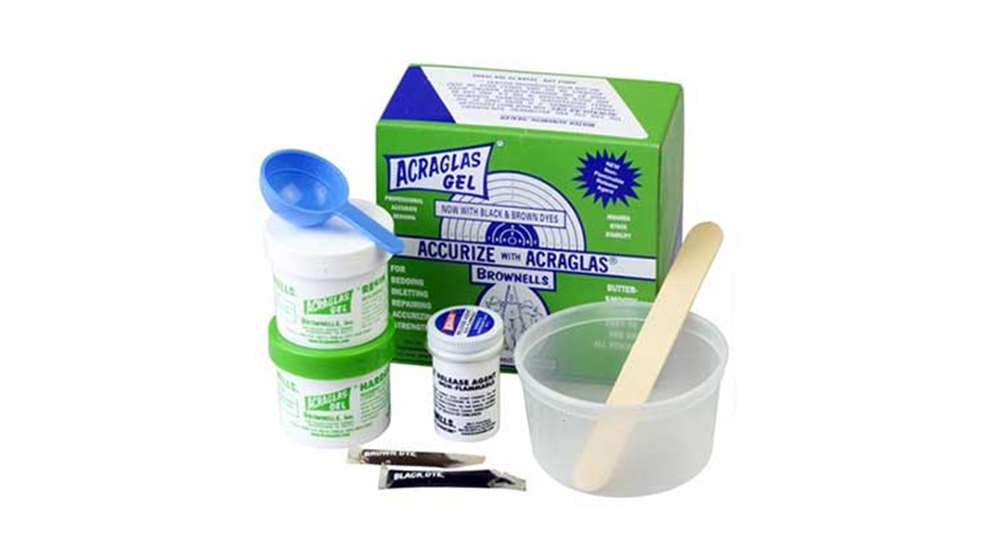
I took the plunge and decided to do a glass bedding job on my Winchester Model 70 rifle. I bought Brownells Acraglas, followed the directions and got good results. But, being my first attempt, it was pretty messy when I got the barreled action out of the stock. I used a file and sandpaper to clean the extra Acraglas that leaked into the magazine hole.
Despite really painting on the release agent included with the kit, I had a heck of a time getting the trigger guard screws out and spent more than 30 minutes trying to pry the action out of the stock. I was afraid I’d glued the whole thing together forever. My questions are: Did I use enough release agent, and what happens when you attempt this job and it just won’t pull apart?
Bryce Jackson
Kodiak, AK
Bedding a rifle is a great way to help accurize it—if done correctly. You chose a great product, but there’s a right way and a wrong way to do everything. While I can’t go into every bedding step due to space constraints, here are some tips you should consider for your next project.
Before any bedding begins, I use inletting black to paint the bottom and sides of the receiver and barrel all the way to where it exits the stock’s fore-end. Place the barreled action into the stock, and give the receiver a few good whacks with a rubber mallet to make sure it’s seated. When you pull the barreled action out of the stock, inletting black will remain on all the high spots of the stock that are in contact with it. If the rifle is to be free-floated, just remove the high spots. This step needs to be repeated after final bedding.
I have used the release agent that comes with the kit on hundreds of rifles and never had a problem. One key is to make certain the threads of the screws are saturated with the agent as well as the screw holes. I recently used Brownells Acra-Release and found it to be faster and easier than painting on the liquid release, and it cleaned up with less work. It also gets into all the small crevices of the action more efficiently.
There are a number of ways to secure the action to the stock once the Acraglas is applied, and all work well. I prefer to spray the inletting guide screws liberally with Acra-Release and attach them to the barreled action before placing it into the stock for bedding. If any of the gel runs into the stock screw holes, all the better, as it acts as a poor man’s pillar-bedding technique.
Rather then screw the trigger guard into place to hold the action while it cures, I prefer to use surgical tubing. Unfortunately, I somehow lost the tubing I’d used for years and learned that home stores don’t carry it. When I tried a medical supply company, it refused to sell it to me. (I didn’t bother to call Homeland Security to ask why.) Fortunately, Brownells also carries it. With the action set into the stock and the Acraglas in place, just wrap the tubing securely around the stock and over the front of the receiver, and tie it off. I do the same over the rear of the receiver. I apply a bit more pressure with the front piece of tubing to keep from placing any torque on the receiver.
To make cleanup easier, consider filling the magazine mortise in the stock with modeling clay or taping it closed with painter’s tape.
Another important tip to consider is applying electrical tape or Brownells Bedding/Masking Tape to the sides and bottom of the receiver recoil lug. You do not want these areas in contact with the stock after bedding. The key points for proper bedding success are the rear of the lug, the bottom of the receiver and the top of the stock area that supports it, and the front of the receiver forward to include about 3 inches of the barrel contour. The bedding area that supports the rear receiver screw is more for strength and stock stability.
Reconsider prying the action out of the stock after bedding. Instead, place a towel on a wooden table and give the front of the barrel a good whack. Over the years, I’ve had to give a rifle four or five good whacks before it breaks free. Of course, remove the surgical tubing before doing this.
If you screwed up and forgot to use the release agent in all the necessary areas, or a stubborn barreled action refuses to break free, there is one possible solution you can try. Put the whole rifle in a freezer for 24 hours. The metal will contract and break loose. I’ve never had to do this, but three gunsmiths I know recommended the freezer treatment if the barreled action just won’t let go.
Bedding a rifle is not a hard process, but following instructions is important. It’s well worth the effort, because if done correctly, your rifle will be much improved in both the accuracy and durability departments.



































